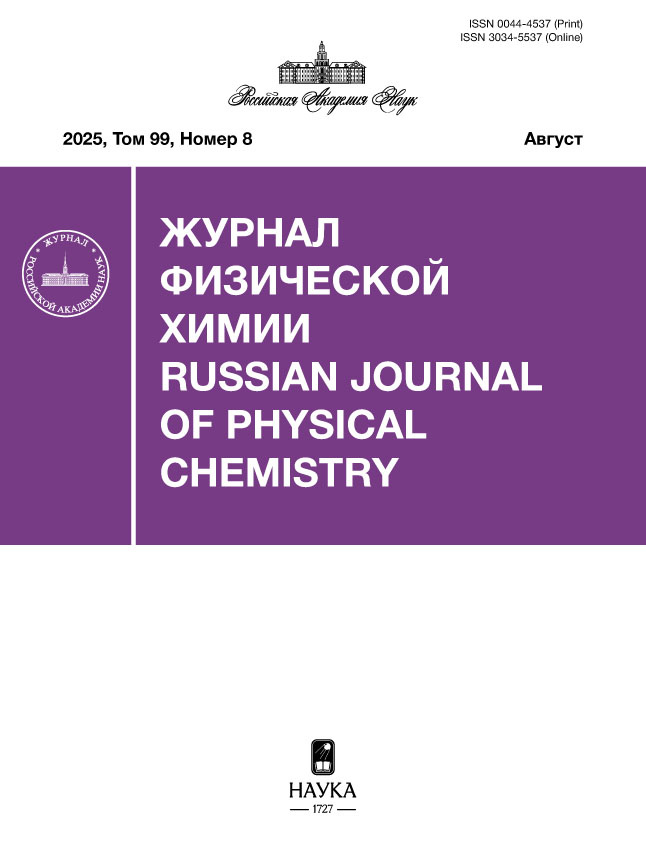Термодинамика реакции восстановления кислорода на поверхности допированного азотом графена
- Авторы: Кисленко В.А.1,2, Павлов С.В.2, Кисленко С.А.2
-
Учреждения:
- Сколковский институт науки и технологий
- Объединенный институт высоких температур РАН
- Выпуск: Том 97, № 11 (2023)
- Страницы: 1547-1555
- Раздел: ХИМИЧЕСКАЯ ТЕРМОДИНАМИКА И ТЕРМОХИМИЯ
- Статья получена: 27.02.2025
- Статья опубликована: 01.11.2023
- URL: https://rjdentistry.com/0044-4537/article/view/669156
- DOI: https://doi.org/10.31857/S0044453723110158
- EDN: https://elibrary.ru/VLDXBV
- ID: 669156
Цитировать
Полный текст
Аннотация
С помощью DFT-моделирования рассчитаны профили свободной энергии реакции восстановления кислорода в кислотной и щелочной средах на поверхности допированного азотом графена в сравнении с бездефектным графеном. Рассмотрены как четырех-, так и двухэлектронный ассоциативный механизм реакции. Расчеты выполнены в большом каноническом ансамбле при фиксированном потенциале электрода. Показано, что расчеты при фиксированном потенциале дают существенное отличие от общепринятого расчета при фиксированном заряде поверхности. Обнаружено, что электрокаталитическое действие азотной примеси связано с ростом энергии хемосорбции интермедиата OOH, что снижает энергию реакции протонирования молекулы кислорода. Также показано, что в щелочной среде азотная примесь ингибирует двухэлектронный механизм реакции.
Ключевые слова
Об авторах
В. А. Кисленко
Сколковский институт науки и технологий; Объединенный институт высоких температур РАН
Email: kislenko@ihed.ras.ru
Россия, Москва; Россия, Москва
С. В. Павлов
Объединенный институт высоких температур РАН
Email: kislenko@ihed.ras.ru
Россия, Москва
С. А. Кисленко
Объединенный институт высоких температур РАН
Автор, ответственный за переписку.
Email: kislenko@ihed.ras.ru
Россия, Москва
Список литературы
- Ferriday T.B., Middleton P.H. // Int. J. Hydrogen Energy. 2021. V. 46. № 35. P. 18489.
- Ma R., Lin G., Zhou Y. et al. // npj Comput. Mater. 2019. V. 5. № 1. P. 78.
- Zhang L., Lin C., Zhang D. et al. // Adv. Mater. 2019. V. 31. № 13. P. 1805252.
- Wang B., Liu B., Dai L. // Adv. Sustain. Syst. 2021. V. 5. № 1. P. 2000134.
- Jia Y., Zhang L., Zhuang L. et al. // Nat. Catal. 2019. V. 2. № 8. P. 688.
- Begum H., Ahmed M.S., Kim Y.-B. // Sci. Rep. 2020. V. 10. № 1. P. 12431.
- Tabassum H., Zou R., Mahmood A. et al. // J. Mater. Chem. A. 2016. V. 4. № 42. P. 16469.
- Lai L., Potts J., Zhan D. et al. // Energy Environ. Sci. 2012. V. 5. № 7. P. 7936.
- Wan K., Yu Z.-P., Li X.-H. et al. // ACS Catal. 2015. V. 5. № 7. P. 4325.
- Rauf M., Zhao Y.-D., Wang Y.-C. et al. // Electrochem. commun. 2016. V. 73. P. 71.
- Yang H., Miao J., Hung S.-F. et al. // Sci. Adv. 2016. V. 2. № 4. P. e1501122.
- Kim I.T., Song M., Kim Y. et al. // Int. J. Hydrogen Energy. 2016. V. 41. № 47. P. 22026.
- Guo D., Shibuya R., Akiba C. et al. // Science. 2016. V. 351. № 6271. P. 361.
- Okamoto Y. // Appl. Surf. Sci. 2009. V. 256. № 1. P. 335.
- Ikeda T., Boero M., Huang S.-F. et al. // J. Phys. Chem. C. 2008. V. 112. № 38. P. 14706.
- Zhang L., Xia Z. // Ibid. 2011. V. 115. № 22. P. 11170.
- Wan X., Shui J. // Sci. Adv. 2022. V. 1. № 1. P. e1400129.
- Nørskov J.K., Rossmeisl J., Logadottir A. et al. // J. Phys. Chem. B. 2004. V. 108. № 46. P. 17886.
- Yu L., Pan X., Cao X. et al. // J. Catal. 2011. V. 282. № 1. P. 183.
- Oberhofer H. Handbook of Materials Modeling. Methods: Theory and Modeling. Cham: Springer International Publishing, 2018. 1987 p.
- Sundararaman R., Goddard W.A., Arias T.A. // J. Chem. Phys. 2017. V. 146. № 11. P. 114104.
- Kim D., Shi J., Liu Y. // J. Am. Chem. Soc. 2018. V. 140. № 29. P. 9127.
- Kislenko V.A., Pavlov S.V., Kislenko S.A. // Electrochim. Acta. 2020. V. 341. P. 136011.
- Pavlov S.V., Kislenko V.A., Kislenko S.A. // J. Phys. Chem. C. 2020. V. 124. № 33. P. 18147–18155.
- Gao G., Wang L.-W. // J. Catal. 2020. V. 391. P. 530.
- Sundararaman R., Letchworth-Weaver K., Schwarz K. et al. // SoftwareX. 2017. V. 6. P. 278.
- Grimme S., Antony J., Ehrlich S. et al. // J. Chem. Phys. 2010. V. 132. № 15. P. 154104.
- Garrity K.F., Bennett J.W., Rabe K.M. et al. // Comput. Mater. Sci. 2014. V. 81. P. 446.
- Kakaei K., Esrafili M.D., Ehsani A. Chapter 6 – Oxygen Reduction Reaction // Graphene Surfaces / ed. Kakaei K., Esrafili M.D., Ehsani A. Elsevier, 2019. V. 27. P. 203–252.
- Yan H.J., Xu B., Shi S.Q., Ouyang C.Y. // J. Appl. Phys. 2012. V. 112. № 10. P. 104316.
- Gunceler D., Letchworth-Weaver K., Sundararaman R. et al. // Model. Simul. Mater. Sci. Eng. 2013. V. 21. № 7. P. 74005.
- Ashcroft N., Mermin D. Solid State Physics. Cengage Learning, 1976. 848 p.
- Sorescu D.C., Jordan K.D., Avouris P. // J. Phys. Chem. B. 2001. V. 105, № 45. P. 11227.
- Heller I., Kong J., Williams K.A. et al. // J. Am. Chem. Soc. 2006. V. 128. № 22. P. 7353.
- Savin G.I., Shabanov B.M., Telegin P.N., Baranov A.V. // Lobachevskii J. Math. 2019. V. 40. № 11. P. 1853.
- Zacharov I., Arslanov R., Gunin M. et al. // Open Eng. 2019. V. 9. № 1. P. 512.
Дополнительные файлы

















